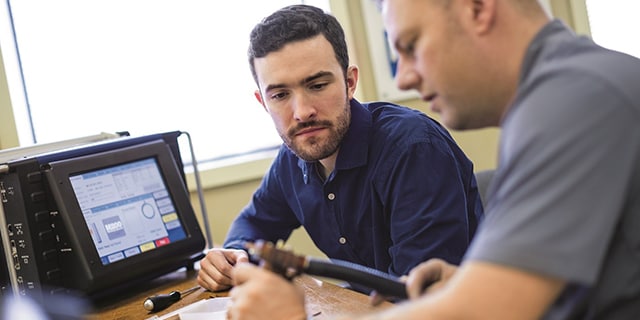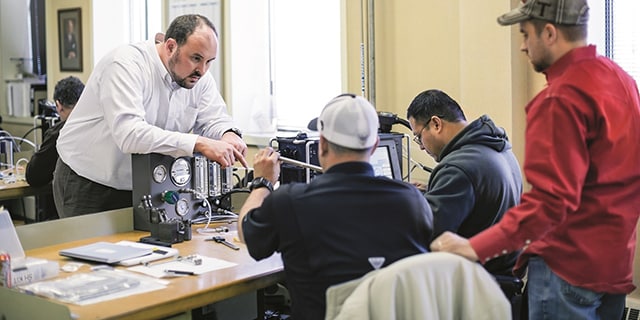Orbital Welding Training: Tools for the Emerging Welding Workforce

Orbital Welding Training: Tools for the Emerging Welding Workforce
Finding skilled welders is becoming difficult and will only become more difficult in the near future. According to the American Welding Society (AWS), more than half of the existing welder workforce is nearing retirement; the average age of a welder is 55. By 2020, the country could be short as many as 291,000 welders.
One means of addressing this shortage is through automated systems, which produce more work with fewer people. Since its introduction in the 1960s, automatic orbital Gas Tungsten Arc Welding (GTAW) has gained popularity in a variety of industries in which maximum leak integrity, high performance, or ultra-cleanliness are of paramount importance. Automated orbital welding systems enhance the operator’s ability to make controlled, repeatable, high-quality, and well-documented welds. The key advantage of GTAW is its precise control of heat input, making orbital welding one of the preferred processes for joining thin gauge metals and for welding in close proximity to heat-sensitive components.
Automated orbital welding, however, does not diminish the need for an educated and well-trained welding workforce. An automatic machine does not negate the need for human expertise. Arguably, automation requires even more training, not less. Weld Operators must still possess all the most basic industry knowledge: material compositions, metallurgy, set-up, purge (backing) and shielding gases, power and voltages, weld pool dynamics, electrode size, and tip configurations. But, they must additionally understand how the automated welding system operates, how it will react to different inputs, and what documentation to require of materials suppliers.
Orbital Welding Training Considerations
The market provides a range of training programs for operators of automatic GTAW machines. Some programs are as short as two days, while others can last up to a week. While lengthy training programs may interrupt operations, the long-term benefits far outweigh the temporary disadvantages.
When selecting a program, look for technical specificity and detail, as well as hands-on learning opportunities. Review the training materials and evaluate their quality to ensure they are useful to your team’s specific needs. For example, quality orbital welding training programs will educate your welder operators for situations in which the material composition of the two metals being welded is dissimilar.
The level of the instructor’s expertise is as important as the content in a training program. Seek out programs taught by certified welding instructors and do your research. A single bad weld can result in a detrimental loss in materials—costing your organization more than a quality training program.
Students should learn that the goal of automatic welding is to produce accurate and repeatable weld current levels during each weld cycle. Good training programs explain the process of orbital welding technology—including principles of operation, advantages, limitations, problems, and variables. To prepare trainees for the equipment they will be expected to master on the job, instructors should cover power supplies in-depth.
Understanding Gases in the Orbital Welding Process
Shielding Gases
When evaluating orbital welding training programs, look at the amount of instruction devoted to shielding gases and the importance of purging. Trainees should learn how shielding gases protect the electrode and the molten weld metal from atmospheric contamination. The most common gases used for shielding in GTAW are argon, helium, and mixtures of the two—typically used for special applications.
Welders must know the preferred ratio of helium to argon. The chief factor influencing shielding effectiveness is gas density. Argon, which is 1.33 denser than air, effectively covers the weld area and displaces the atmosphere. Helium has less density and tends to rise instead of flowing to the work area. To produce equivalent shielding, the flow of helium must be two or three times the flow of argon.
Shielding gases can affect the metallurgical properties of some materials. Generally, the arc is quieter and more stable when shielded by argon rather than other gases. The lower unit costs and lower flow rate requirements of argon make it the preferred choice. Having the knowledge to make a proper judgment in the choice of shielding gas is critical.
Gas Purging
The success of orbital welding jobs can be greatly affected by using proper gas purging techniques, also referred to as backing gas. Many experienced welders fail to understand the importance of this basic concept. Some people in the welding industry consider gas purging to be the Achilles’ heel of welding. Training programs must teach the principles of purging, including how to calculate purge time.
Proper selection of purge gas, typically argon, is the first step to successful purging. Argon is available in varying levels of purity; selecting the proper level for the desired result is essential. Defining and setting the correct flow and pressure through the tubing, or piping, and across the weld joint is one of the most important procedural steps one can take to ensure successful welding. Conversely, it is one of the most likely areas for problems if not properly handled. Gas purging done incorrectly or not at all can ruin entire manufacturing systems. The internal pressure helps keep the weld bead flush to the inside wall surface of the components being welded, while the proper flow will help keep the weld metal and heat-affected zone clean.
Selecting Quality Materials for Welds
Quality welds start with the material. Even the best orbital welding system cannot compensate for poor material used to manufacture tubing, fittings, or other components. Effective training in materials should address issues related to composition and metallurgy, including how sulfur content affects weld quality.
There are four main material families: mild steels, nickel alloys, refractory and reactive metals, and stainless steels. Individuals in orbital welding training programs should learn how to inspect all incoming materials and material certifications, as well as how to assess the documentation.
Mild Steels
For mild steels, it’s important to remember that the quality of orbital welds is highly influenced by the base metal impurity content—the trace amounts of sulfur, phosphorus, oxygen, etc. Also, hydrogen embrittlement of these alloys is a problem if hydrocarbons or water vapor contamination is present.
Nickel Alloys
Nickel alloys offer great material properties and are ideal for heavily corrosive applications, but Nickel alloys can be more difficult to weld due to their susceptibility to cracking.
Refractory and Reactive Metals
Orbital welding is the most extensively used welding process for joining refractory and reactive metal tubing and pipe. Refractory metals (molybdenum, tantalum, etc.) and reactive metals (titanium, zirconium, etc.) are readily oxidized at elevated temperatures unless protected by an inert gas cover. For these metals and alloys, Orbital GTAW can provide a high concentration of heat, the greatest control over heat input, and the best inert gas shielding of any arc welding process.
Stainless Steels
Stainless steels have excellent corrosion resistance due to the minimum 10.5% of Chromium which helps them to create an instantaneous oxide layer to protect the other elements inside of the material. These other elements help to define the microstructure of the material as either Austenite, Ferrite, or a balanced mix of the two found in Duplex Stainless Steel. Stainless Steels are generally considered weldable, but the different microstructures all have different considerations that must be addressed when welding.
Sulfur Content
Another major factor in orbital welding is the sulfur content of the materials. Sulfur is often added to material to make it easier to machine and form. In welding, the level of sulfur can change the surface tension of the weld, affecting the heat flow and the penetration characteristics of the material. It’s especially critical that orbital welding trainees learn the importance of the sulfur differential between the components being welded. Attempting to weld components with significant differential in sulfur content will likely produce a bead shift toward the component with the lower sulfur content, potentially causing the weld bead to partially miss the joint.
Knowledge
The escalating welder shortage affects tomorrow’s global manufacturing. Automatic orbital welding, which can produce more output with fewer people depending on the specific job, equipment, and skillsets, may help combat the problem. The misconception exists that automation associated with orbital welding systems eliminates the need for training, since the machine is doing the welding. But the opposite is true: well-rounded and up-to-date training is more essential than ever for welders. Only through quality training taught by certified instructors can operators of orbital welding equipment gain the complex skills—beyond making connections and performing welds—needed to meet the strict acceptance criteria in today’s welding environment.
Interested in registering your team in Swagelok’s five-day orbital welding training course? Complete a registration form to your authorized Swagelok sales and service center for local price information and additional training details.
Related Articles

Closing the Manufacturing Skills Gap: Develop a Well-Trained Team
With an aging industrial workforce nearing retirement, manufacturers are turning to younger generations to replace expert knowledge. Learn how to build an effective fluid system training program with expert advice from Swagelok.

